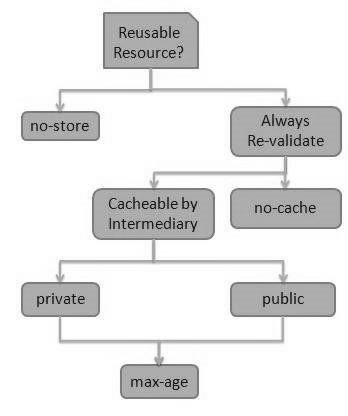- RESTful Web服务-方法
- RESTful Web服务教程Spring Boot RESTful Web服务(1)
- RESTful Web服务教程Spring Boot RESTful Web服务
- RESTful Web 服务 API (1)
- RESTful Web服务教程
- RESTful Web服务教程(1)
- RESTful Web服务-资源(1)
- RESTful Web服务-资源
- RESTful Web服务-简介
- RESTful Web服务-简介(1)
- RESTful Web服务-无状态
- RESTful Web服务-无状态(1)
- 讨论RESTful Web服务(1)
- 讨论RESTful Web服务
- 初始化RESTful Web服务
- 初始化RESTful Web服务
- 初始化RESTful Web服务(1)
- RESTful Web 服务中的协议 (1)
- RESTful Web 服务 API - 任何代码示例
- RESTful Web服务-环境设置
- RESTful Web服务-环境设置(1)
- RESTful Web服务-安全性(1)
- RESTful Web服务-安全性
- RESTful Web服务-第一个应用程序(1)
- RESTful Web服务-第一个应用程序
- RESTful Web服务-寻址(1)
- RESTful Web服务-寻址
- RESTful Web 服务中的协议 - 任何代码示例
- RESTful Web服务-有用的资源
📅 最后修改于: 2020-10-20 04:38:50 🧑 作者: Mango
缓存是指将服务器响应存储在客户端本身中,因此客户端无需一次又一次地请求服务器请求相同的资源。服务器响应应该具有有关如何进行缓存的信息,以便客户端在一段时间内缓存响应,或者永远不要缓存服务器响应。
以下是服务器响应可以具有的标头,用于配置客户端的缓存-
| Sr.No. | Header & Description |
|---|---|
|
1 |
Date Date and Time of the resource when it was created. |
|
2 |
Last Modified Date and Time of the resource when it was last modified. |
|
3 |
Cache-Control Primary header to control caching. |
|
4 |
Expires Expiration date and time of caching. |
|
5 |
Age Duration in seconds from when resource was fetched from the server. |
缓存控制标头
以下是Cache-Control标头的详细信息-
| Sr.No. | Directive & Description |
|---|---|
|
1 |
Public Indicates that resource is cacheable by any component. |
|
2 |
Private Indicates that resource is cacheable only by the client and the server, no intermediary can cache the resource. |
|
3 |
no-cache/no-store Indicates that a resource is not cacheable. |
|
4 |
max-age Indicates the caching is valid up to max-age in seconds. After this, client has to make another request. |
|
5 |
must-revalidate Indication to server to revalidate resource if max-age has passed. |
最佳实践
-
始终保持静态内容(如图像,CSS,JavaScript)可缓存,并且有效期为2到3天。
-
切勿将有效期过高。
-
动态内容应仅缓存几个小时。
